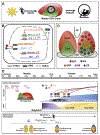Circuit development in the master clock network of mammals
- PMID: 30402923
- PMCID: PMC6502707
- DOI: 10.1111/ejn.14259
Circuit development in the master clock network of mammals
Abstract
Daily rhythms are generated by the circadian timekeeping system, which is orchestrated by the master circadian clock in the suprachiasmatic nucleus (SCN) of mammals. Circadian timekeeping is endogenous and does not require exposure to external cues during development. Nevertheless, the circadian system is not fully formed at birth in many mammalian species and it is important to understand how SCN development can affect the function of the circadian system in adulthood. The purpose of the current review is to discuss the ontogeny of cellular and circuit function in the SCN, with a focus on work performed in model rodent species (i.e., mouse, rat, and hamster). Particular emphasis is placed on the spatial and temporal patterns of SCN development that may contribute to the function of the master clock during adulthood. Additional work aimed at decoding the mechanisms that guide circadian development is expected to provide a solid foundation upon which to better understand the sources and factors contributing to aberrant maturation of clock function.
Keywords: circadian clock; clock genes; postnatal development; suprachiasmatic nucleus.
© 2018 Federation of European Neuroscience Societies and John Wiley & Sons Ltd.
Conflict of interest statement
Conflict of Interest
The author declares that there is no conflict of interest that could be perceived as prejudicing the impartiality of the research reported.
Figures

Similar articles
-
Synchronization of the mammalian circadian timing system: Light can control peripheral clocks independently of the SCN clock: alternate routes of entrainment optimize the alignment of the body's circadian clock network with external time.Bioessays. 2015 Oct;37(10):1119-28. doi: 10.1002/bies.201500026. Epub 2015 Aug 7. Bioessays. 2015. PMID: 26252253 Free PMC article. Review.
-
Development of the mammalian circadian clock.Eur J Neurosci. 2020 Jan;51(1):182-193. doi: 10.1111/ejn.14318. Epub 2019 Jan 30. Eur J Neurosci. 2020. PMID: 30589961 Review.
-
Regulation and function of extra-SCN circadian oscillators in the brain.Acta Physiol (Oxf). 2020 May;229(1):e13446. doi: 10.1111/apha.13446. Epub 2020 Feb 6. Acta Physiol (Oxf). 2020. PMID: 31965726 Review.
-
Circadian Tick-Talking Across the Neuroendocrine System and Suprachiasmatic Nuclei Circuits: The Enigmatic Communication Between the Molecular and Electrical Membrane Clocks.J Neuroendocrinol. 2015 Jul;27(7):567-76. doi: 10.1111/jne.12279. J Neuroendocrinol. 2015. PMID: 25845396 Free PMC article. Review.
-
Nutrients and Circadian Rhythms in Mammals.J Nutr Sci Vitaminol (Tokyo). 2015;61 Suppl:S89-91. doi: 10.3177/jnsv.61.S89. J Nutr Sci Vitaminol (Tokyo). 2015. PMID: 26598902
Cited by
-
Different Roles for VIP Neurons in the Neonatal and Adult Suprachiasmatic Nucleus.J Biol Rhythms. 2020 Oct;35(5):465-475. doi: 10.1177/0748730420932073. Epub 2020 Jun 15. J Biol Rhythms. 2020. PMID: 32536240 Free PMC article.
-
Sleep-wake cycle disturbances and NeuN-altered expression in adult rats after cannabidiol treatments during adolescence.Psychopharmacology (Berl). 2021 Jun;238(6):1437-1447. doi: 10.1007/s00213-021-05769-z. Epub 2021 Feb 26. Psychopharmacology (Berl). 2021. PMID: 33635384
-
The Lineage Before Time: Circadian and Nonclassical Clock Influences on Development.Annu Rev Cell Dev Biol. 2020 Oct 6;36:469-509. doi: 10.1146/annurev-cellbio-100818-125454. Annu Rev Cell Dev Biol. 2020. PMID: 33021821 Free PMC article. Review.
-
Reduced VIP Expression Affects Circadian Clock Function in VIP-IRES-CRE Mice (JAX 010908).J Biol Rhythms. 2020 Aug;35(4):340-352. doi: 10.1177/0748730420925573. Epub 2020 May 28. J Biol Rhythms. 2020. PMID: 32460660 Free PMC article.
-
Ontogenetic rules for the molecular diversification of hypothalamic neurons.Nat Rev Neurosci. 2022 Oct;23(10):611-627. doi: 10.1038/s41583-022-00615-3. Epub 2022 Jul 29. Nat Rev Neurosci. 2022. PMID: 35906427 Review.
References
-
- Abizaid A, Mezei G, Sotonyi P & Horvath TL (2004) Sex differences in adult suprachiasmatic nucleus neurons emerging late prenatally in rats. Eur J Neurosci, 19, 2488–2496. - PubMed
-
- Abrahamson EE & Moore RY (2001) Suprachiasmatic nucleus in the mouse: Retinal innervation, intrinsic organization and efferent projections. Brain Res, 916, 172–191. - PubMed
-
- Aida R, Moriya T, Araki M, Akiyama M, Wada K, Wada E & Shibata S (2002) Gastrin-releasing peptide mediates photic entrainable signals to dorsal subsets of suprachiasmatic nucleus via induction of Period gene in mice. Mol Pharmacol, 61, 26–34. - PubMed
Publication types
MeSH terms
Grants and funding
LinkOut - more resources
Full Text Sources

